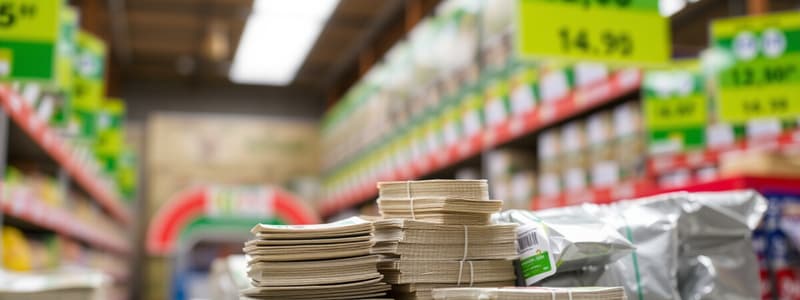Podcast
Questions and Answers
What is the definition of supply?
What is the definition of supply?
- The amount of goods available (correct)
- The total cost of production
- The quality of goods available
- The legal restrictions on goods
What does the law of supply state?
What does the law of supply state?
Suppliers tend to offer more of a good at a higher price; as the price increases, the quantity supplied increases, and vice versa.
What is a supply schedule?
What is a supply schedule?
- A graph showing the quantity supplied
- A measure of production costs
- A chart that lists how much of a good a supplier will offer at different prices (correct)
- A curve indicating demand
What is meant by variable in economics?
What is meant by variable in economics?
What is a market supply schedule?
What is a market supply schedule?
What does the supply curve represent?
What does the supply curve represent?
Define elasticity of supply.
Define elasticity of supply.
What is an example of inelastic supply?
What is an example of inelastic supply?
What best describes elastic supply?
What best describes elastic supply?
What does marginal product of labor indicate?
What does marginal product of labor indicate?
What are fixed costs?
What are fixed costs?
What happens to marginal cost?
What happens to marginal cost?
What is a subsidy?
What is a subsidy?
What does the term inflation refer to?
What does the term inflation refer to?
Flashcards are hidden until you start studying
Study Notes
Supply and Related Concepts
- Supply: Refers to the total amount of goods available for sale in the market.
- Law of Supply: Indicates that suppliers are inclined to offer increased quantities of a good when prices rise, and conversely, supply decreases as prices fall.
- Quantity Supplied: The specific amount of a product that suppliers are willing to sell at a given price.
- Supply Schedule: A tabular representation detailing how much of a product will be supplied at various price points, illustrating the price-quantity relationship.
- Variable: Any factor that can change, affecting supply and demand dynamics.
Market Dynamics
- Market Supply Schedule: A comprehensive chart showing the total quantity of a good that all suppliers will offer at different prices in the market.
- Supply Curve: A graphical depiction of the quantity supplied at various price levels, with the horizontal axis showing the quantity supplied.
- Market Supply Curve: Represents the total quantity supplied by all suppliers at different prices; typically illustrates that higher prices incentivize greater output.
Elasticity and Production Response
- Elasticity of Supply: Measures how much the quantity supplied changes in response to price variations, indicating supplier responsiveness.
- Inelastic Supply: Describes industries that cannot easily adjust production levels; for instance, orange groves have fixed production capabilities.
- Elastic Supply: Industries that can readily change production levels, such as barber shops, reflect a more elastic supply.
- Unitary Elastic: A specific case where elasticity is exactly one, indicating proportional responsiveness in quantity supplied due to price change.
Labor and Production
- Marginal Product of Labor: Refers to the additional output generated from hiring one more labor unit.
- Increasing Marginal Returns: A situation where the marginal product of labor grows as the workforce expands, leading to more efficient production.
- Diminishing Marginal Returns: Occurs when adding more workers results in a decrease in the marginal product, suggesting inefficiencies.
Costs of Production
- Fixed Cost: Costs that remain constant regardless of production levels, such as rent or machinery maintenance.
- Variable Cost: Costs that fluctuate with production volume, including expenses for labor, utilities, and raw materials.
- Total Cost: The sum of fixed and variable costs, giving a complete view of production expenses.
- Marginal Cost: The expense incurred from producing one additional unit of a good, crucial for decision-making.
- Marginal Revenue: The extra income received from selling one more unit of a product; often equals the selling price.
Regulatory Factors and Economic Conditions
- Operating Cost: Encompasses all costs associated with running a facility, significant for overall profitability assessments.
- Subsidy: Government financial support aimed at assisting businesses or specific markets, often to promote production.
- Excise Tax: A government-imposed tax on specific goods during their production or sale, impacting pricing strategies.
- Regulation: Government interventions that influence market conditions, affecting production quantities, costs, and quality.
- Inflation: An economic condition characterized by general rising prices, impacting supply and demand decisions.
Studying That Suits You
Use AI to generate personalized quizzes and flashcards to suit your learning preferences.




